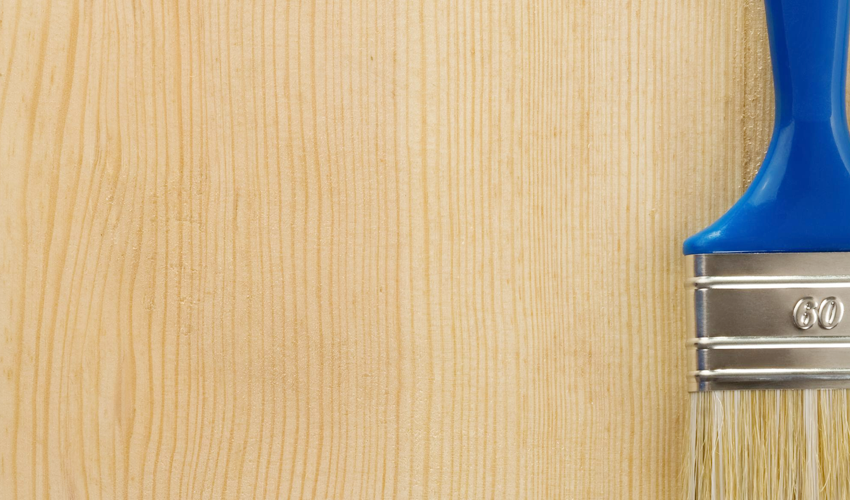Table of Contents
The Complete Guide to Choosing Wood Finishes
Wood finishes and coatings are applied to wooden surfaces to protect them from damage and enhance their appearance. There are many different types of finishes and coatings available in the market today, including oil finishes, varnishes, lacquers, and stains.
Each type of finish or coating has its own unique properties, and the choice of which to use will depend on the specific application and the desired outcome. Some finishes, such as oil finishes, provide a natural, unpolished look, while others, such as varnishes and lacquers, create a glossy, polished surface. Stains are used to add colour to wood, while coatings such as polyurethane provide an extra layer of protection.
Intrigued to learn more about the popular types of wood finishes that you can use for your old and new furniture in 2024? Keep reading as we discuss everything, from the different types of wood finishes, tips on how to use them correctly and key factors to keep in mind while choosing the right wood finish for your furniture.
Wood Finishing
Wood finishing is always necessary or advised by interior painting professionals, regardless of whether the wooden object is new or old. A high-quality finish can not only help keep the furniture in good condition for many years but also add an aesthetically pleasing look to it.
Types of Wood Finishes and Coatings
Here are some of the most popular types of wood finishes and a quick guide on how and when to consider using them for your wooden furniture.
Wood Stains
The most common kind of interior stains is oil-based. Oil-based stains have excellent resistance to moisture and do not require a sealer, so they are usually the best choice for wood that will be exposed to weather or water. This type of finish is applied to the wood surface by rubbing in a thin layer of oil, such as linseed oil or tung oil.
Compared to other stains, gel-based stains don’t need as much preparation. While gel-based stains are typically easier to apply, oil-based stains have superior durability and can last much longer. Water-based stains are quick to dry and simple to remove compared to other types of stains. They are simple to apply with a brush or rag. It penetrates the wood, providing a natural-looking finish that brings out the grain and colour of the wood.
Varnish on Wood
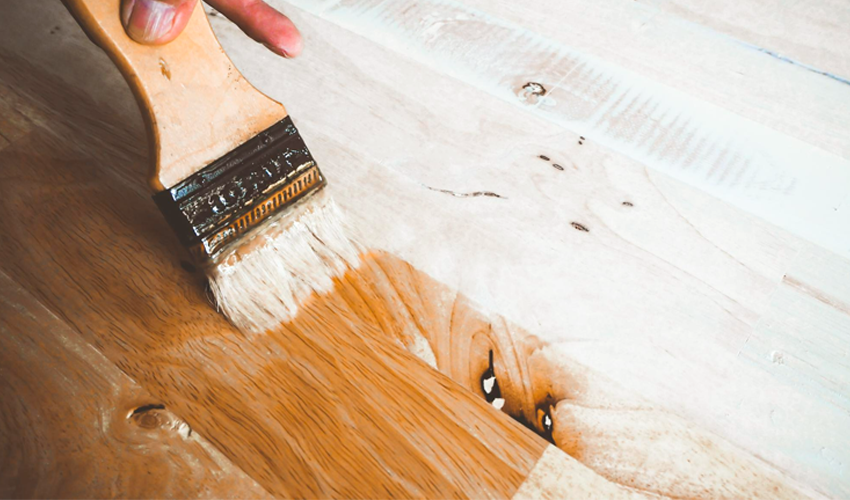
Varnish is a clear and transparent finish that is applied to the wood surface. It is made from a mixture of resin, drying oil and solvent. It provides a durable and highly glossy finish. Note that this finish requires spray equipment and an advanced level of brushing skills to achieve a flawless finish.
Polyurethane Wood Coating and Finishes
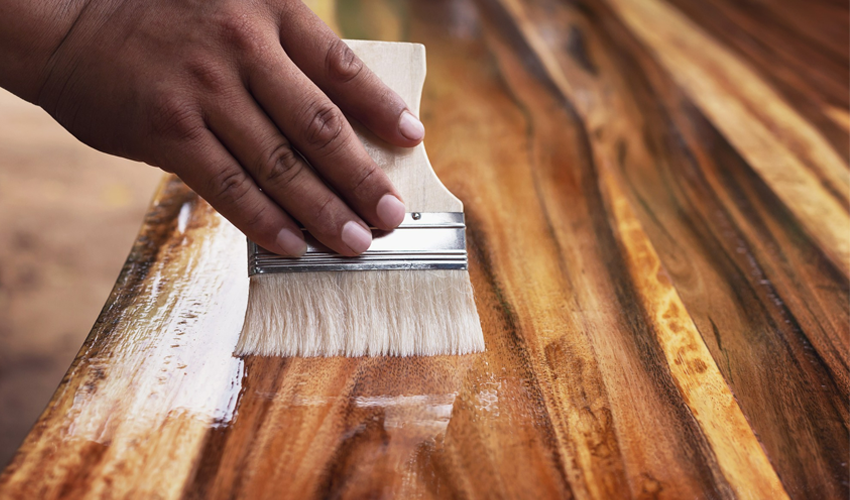
Polyurethane is a durable and water-resistant finish that gives your wooden surfaces excellent protection against several environmental factors like water, UV rays, etc. Note that it enhances the natural appearance of your wooden furniture and is a great choice for people who want to give their wooden surface a satin or moderate-to-high gloss finish.
Lacquer Wood Coating

Lacquer is a transparent coating for wood that creates a hard and durable finish. It is popularly used for wooden cabinets, doors and shelves. You can apply this finish to your wooden surface with either a spray gun or a brush. Note that this wood finish is more durable than a shellac wood coating.
Shellac Wood Coating

Shellac is a natural resin that is derived from the lac bug. It is dissolved in alcohol to create a mellow finish that is perfect for wooden furniture made from mahogany, walnut, etc. This coating for wood is not that durable and it is difficult to apply as it requires special clog spray equipment. Note that this wood coating paint is often used by wood painters for patio furniture.
Wax Wood Coating

Wax is a natural or synthetic product that is applied to the wood surface. It provides a natural-looking finish that brings out the grain and colour of the wood. Wax also adds a protective layer to the wood, helping it resist dirt and moisture that can otherwise cause damage over time.
Wood Oils and Penetrating Finishes
Wood oils and penetrating finishes are used to protect and enhance the natural beauty of wood surfaces. They are designed to penetrate deep into the wood grain, nourishing and protecting the wood from within.
Tung Oil

Tung oil is a natural oil that is extracted from the nuts of the tung tree. It is a popular choice for wood finishing because it is easy to apply, dries quickly, and enhances the natural colour and grain of the wood.
Linseed Oil
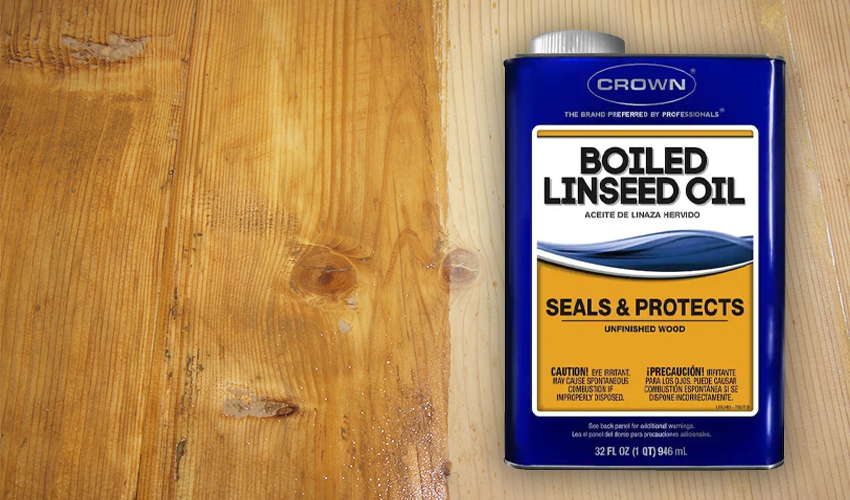
Linseed oil is another natural oil that is extracted from flax seeds. It is a traditional wood-finishing oil that has been used for centuries. It dries to a hard, durable finish and enhances the natural colour and grain of the wood.
Danish Oil

Danish oil is a blend of natural oils and resins that is designed to penetrate deeply into the wood grain. It is easy to apply, dries quickly, and provides a durable, water-resistant finish.
Teak Oil
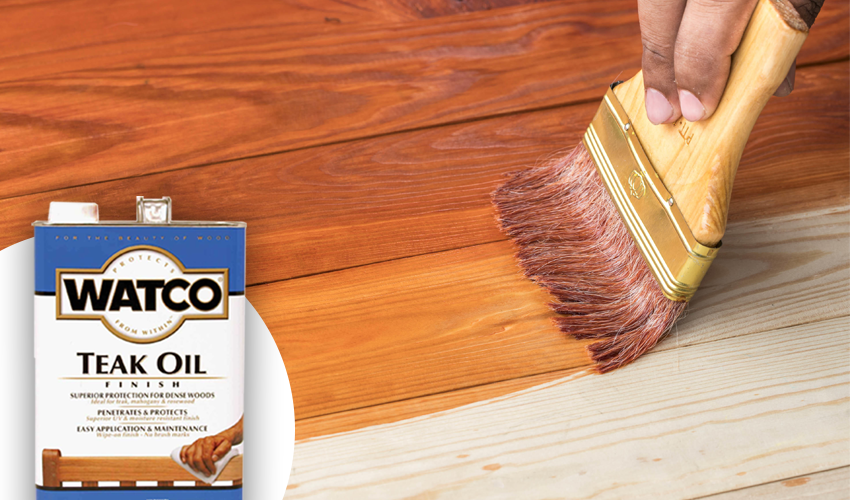
Teak oil is a specialised oil that is designed for use on teak wood. It is formulated to enhance the natural colour and grain of teak and provide a durable, water-resistant finish.
Wood Coatings

Wood coatings are used to protect and enhance the appearance of wood surfaces. They can come in the form of paint, stains, varnishes, and sealers. They provide protection against weather, water, and UV rays, as well as enhance the natural beauty of the wood grain. Some coatings are also formulated to resist mould and mildew growth. Proper application and maintenance of wood coatings can help prolong the life of wood surfaces, such as decks, fences, and outdoor furniture.The final stage of wood finishing involves applying coatings, which give wooden surfaces a desirable appearance. Additionally, wood coatings can be used to create customised wooden designs. It looks good, works well for a longer time, and is more durable with wood finishing. Both interior and exterior painting wooden designs can benefit from the use of these wooden finishing products. Most commonly, wood coatings are also referred to as wood polish and wood colours.
French Polish

Want a deep, vibrant and highly glossy sheen for your wooden furniture. That is where this finish comes into the picture. It involves applying many thin coats of shellac with a fabric dabber. French polish is a great wooden finish for people who want a rich look for their wooden surface and don’t mind a labour intensive process to achieve it.
Water-Based Wood Finishes
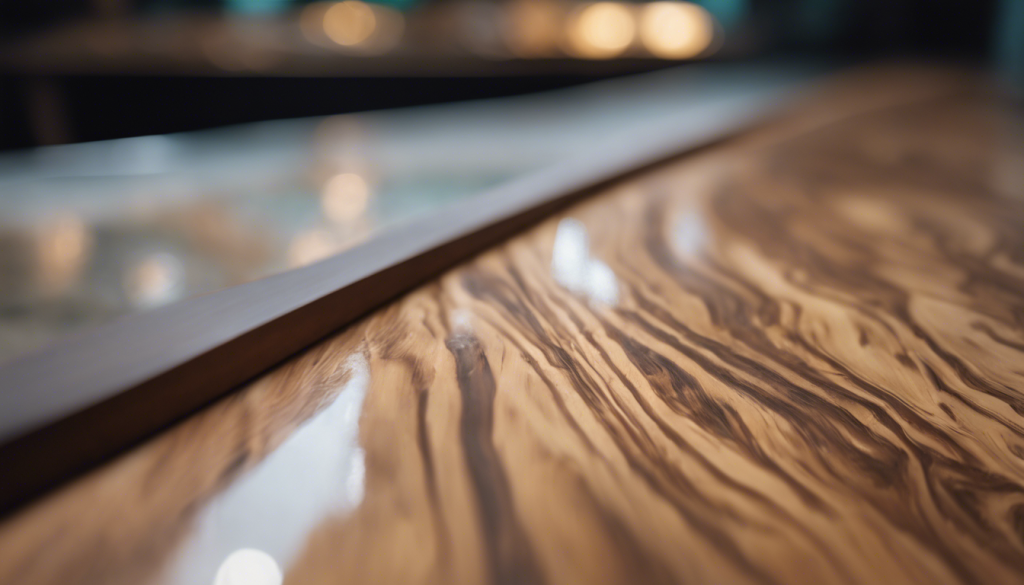
Homeowners who are looking for wood finishes that give a natural sheen to their wooden furniture must check out water-based wood finishes. These wood finishes dry up quickly and they are easy to apply, as you simply need a synthetic brush to apply them to your wooden surface. They are ideal for absorbent timbers like pine, plywood, cork etcs., as oil-based wood finishes might cause yellowing on these wooden surfaces.
Factors to Consider When Choosing a Wood Finish
Here are some of the primary factors that you must keep in mind while finalising a wood finish for your wooden furniture.
- Durability: The durability of a wood finish is an important factor to consider when choosing a finish. Some finishes are more durable than others and will last longer without needing to be reapplied.
- Colour and Appearance: The colour and appearance of a wood finish are also important to consider. Some finishes enhance the natural colour of the wood, while others change the colour of the wood.
- Compatibility: It is important to choose a wood finish that is compatible with the type of wood you are working with. Certain finishes may be more appropriate for a specific type of wood than others.
- Ease of Application: The ease of application of a wood finish is also an important factor to consider. While certain finishes require an elaborate technique and are time consuming to apply, others are easy to apply and take less time.
- VOCs: Volatile organic compounds (VOCs) are chemicals that can be harmful to human health and the environment. It is important to choose a wood finish that has low or no VOCs.
- Cost: The cost of a wood finish is also an important factor to consider. Some finishes can be expensive, while others are more affordable.
- Maintenance: Some wood finishes require more maintenance than others. It is important to choose a wood finish that is easy to maintain.
- Gloss Level: Certain wood finishes will provide a glossy finish, while others will provide a matte finish. Choose a finish that provides the level of gloss you want.
Tips for Wood Finishing and Coating
Here are some handy tips to keep in mind while painting your wooden surfaces:
- Start with a clean surface: Before applying any finish, make sure the wood is clean and free of dust, dirt, and debris. Use a soft cloth or brush to remove any loose particles and then use a wood cleaner to remove any remaining dirt or grime.
- Sand the wood: Sand the wood with fine-grit sandpaper to remove any rough spots and smooth out the surface. This will also help the finish adhere better.
- Test the finish: Always test the finish on a small, inconspicuous area of the wood to ensure that you are happy with the colour and finish before applying it to the entire piece.
- Application: Apply the finish in thin, even coats, using a brush or cloth to work it into the wood. Allow each coat to dry completely before applying the next one.
- Allow ample drying time: After the final coat, allow the finish to dry completely before using the piece. This can take anywhere from a few hours to a few days, depending on the type of finish and the humidity in the air.
- Consider using a sealer: If you are using porous wood, consider applying a sealer before applying the finish. This will help to protect the wood from moisture and staining.
- Use a high-quality brush: Use a high-quality brush to apply the finish, as this will help to ensure a smooth and even finish. A natural bristle brush is recommended for oil-based finishes, while a synthetic brush is best for water-based finishes.
- Avoid over-sanding: When sanding the wood, avoid over-sanding, as this can remove too much of the wood’s natural oils and make the finish less effective.
- Clean up after yourself: After applying the finish, make sure to clean up any tools and materials that you used, as some finishes can be difficult to remove once they have dried.
Conclusion on Wood Coating and Finishes
To conclude, while some finishes provide a natural, unpolished look to your wooden surfaces, others give them a glossy and polished look. Wood painting doesn’t just refresh your furniture; it also helps to increase its durability and longevity. Wood painting is easy if you understand the basics of it. For people who are sceptical about painting their antique wooden furniture pieces on their own, we recommend that you hire a credible wood painting service like that of AapkaPainter and sit back and relax, knowing that your furniture is in safe hands.
Curious to know how much it will cost you to paint your abode this year? Simply use AapkaPainter’s painting cost calculator to get a precise estimate of your total home renovation expense in 2024.
FAQ on Coating for Wood
What is the best finish for wood?
The best finish for wood will depend on the specific project and your personal preferences. It’s always good to consider the durability, resistance to water and UV light, and overall look before making a final decision.
What is the most durable coating for wood?
The most durable coating for wood is polyurethane. It is a clear, plastic-like coating that is applied to wood surfaces and dries to a hard, protective finish. It is resistant to scratches, water, UV light, and other environmental factors, making it an ideal choice for outdoor furniture and indoor furniture in high-traffic areas. Other durable coatings for wood include epoxy and marine varnish.
Is a clear coat good on wood? And what is the best clear coat for wood?
A clear coat can be good on wood as it provides a protective layer that can help preserve the natural beauty of the wood while also making it more durable and resistant to scratches, stains, and other forms of damage. A clear coat also helps to bring out the natural grain and colour of the wood, making it look more vibrant and attractive. However, it is important to use a high-quality clear coat and to apply it properly in order to achieve the best results. The best clear coat for wood depends on the type of wooden surface and the finish you want to achieve. It is recommended to test different options and choose the one that best suits your requirements.
Which paint is best for wood?
This depends on several factors, like the type of wood, its utility, what kind of sheen you want it to have, your budget, etc. Get in touch with the wood painting experts at AapkaPainter today to make an informed choice while shopping for wood finishes in 2024.
How do you coat paint on wood?
To begin with, you must scrape the loose paint if there is any and then nicely sand the wooden surface. Next, apply a primer that will act as an additional protective layer. Sand again if necessary, or move on to the painting step of applying a high-quality wood finish to your wooden furniture. Lastly, apply a clear coat that will help to harden and protect your wooden paint and make it last for years to come.
What is the best way to coat wood?
The best way to coat wood depends on the wood type, its intended use, and the desired finish. For indoor furniture, polyurethane or lacquer offers durability and shine. For outdoor structures, oil-based stains or marine varnish provide weather protection. Always prepare the wood by sanding and cleaning before applying any coating.
What is the best coating to preserve wood?
The optimal wood preservative coating varies based on the wood’s environment. For outdoor use, marine varnish or oil-based stains excel in protecting against UV rays, moisture, and weathering. For indoor furniture, polyurethane or lacquer provides excellent protection against scratches and stains.
What do you coat wood with to protect it?
For indoor applications, polyurethane, lacquer, and shellac are common choices. Outdoor wood benefits from oil-based stains, marine varnish, or water-based sealants. The specific coating depends on factors like desired finish, durability needs, and environmental conditions.
What is wood coating called?
The wood coating is generally referred to as a “wood finish.” However, specific types of coatings include polyurethane, lacquer, varnish, stain, and sealant. Each offers different properties and finishes, catering to various wood applications.
What are the four main types of wood finishes?
The four primary wood finish types are:
Sealers: Prevent stains and moisture penetration.
Stains: Enhance wood grain while adding colour.
Varnishes: Protect wood with a clear, hard finish.
Lacquers: Create a durable, high-gloss finish. Other types include polyurethane, oil finishes, and waxes, each offering distinct characteristics.
What is the best protective coating for wood?
Polyurethane wood finishes are synthetic coatings that are highly durable and water resistant, making them the best clear coat for wood protection.
How to permanently waterproof wood?
While achieving complete and permanent waterproofing of wood is challenging due to its porous nature, several coatings can significantly enhance water resistance. Marine varnish, polyurethane, and epoxy can provide good protection. However, repeated applications and maintenance are usually necessary.
What is the toughest wood coating?
Epoxy is generally considered the toughest wood coating. It offers excellent durability, resistance to chemicals, and water repellency. However, its application can be more complex compared to other coatings, and the final finish might be less aesthetically pleasing for some applications.
